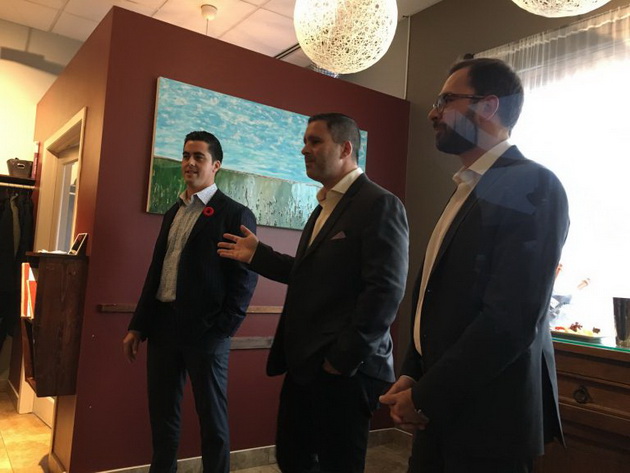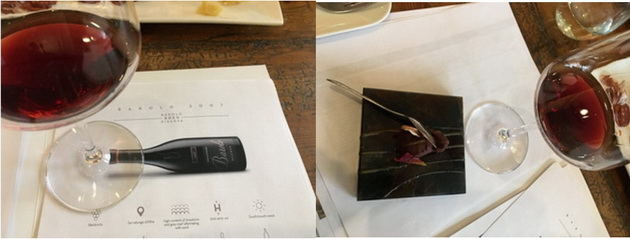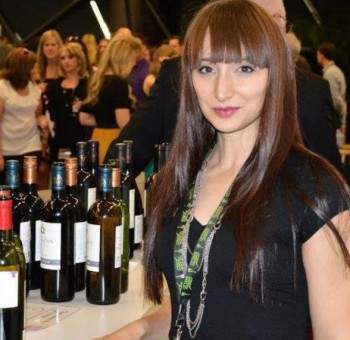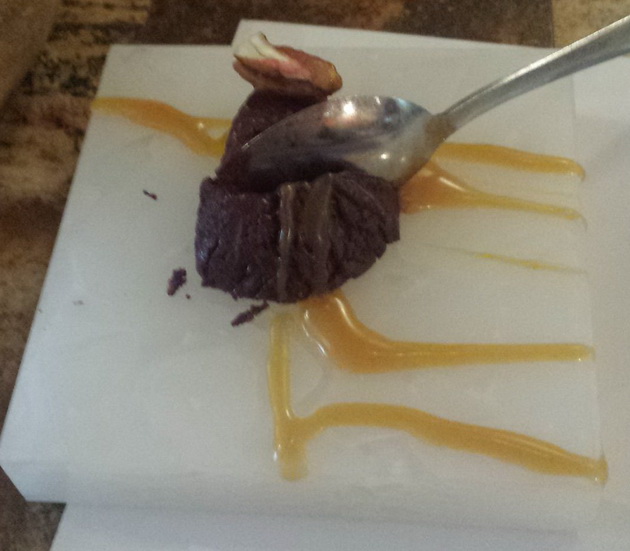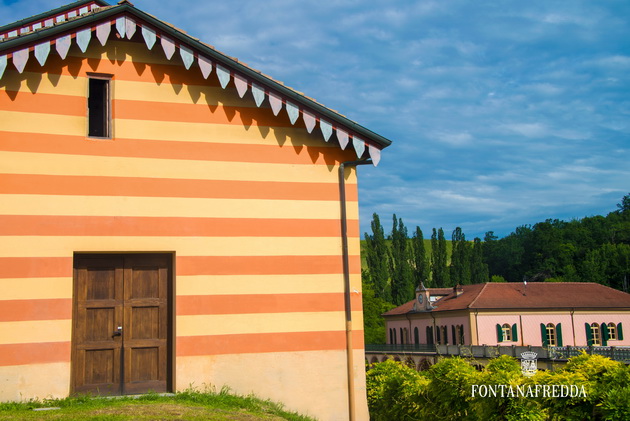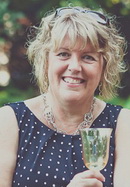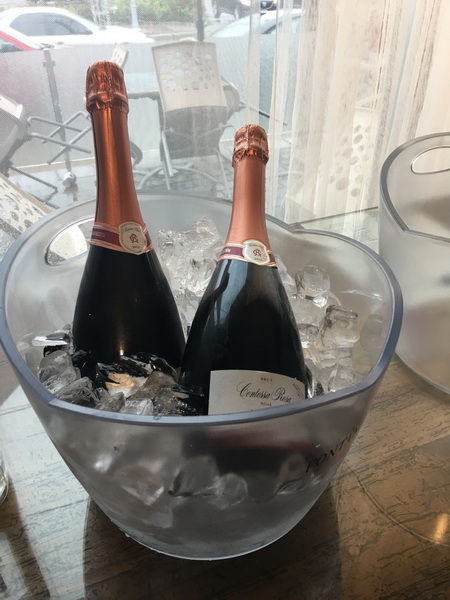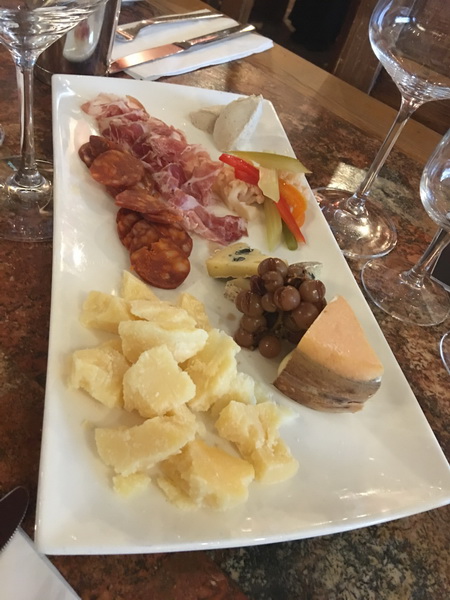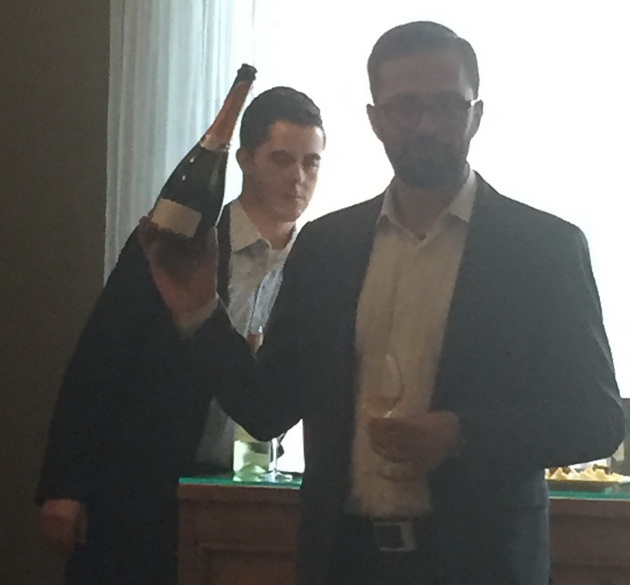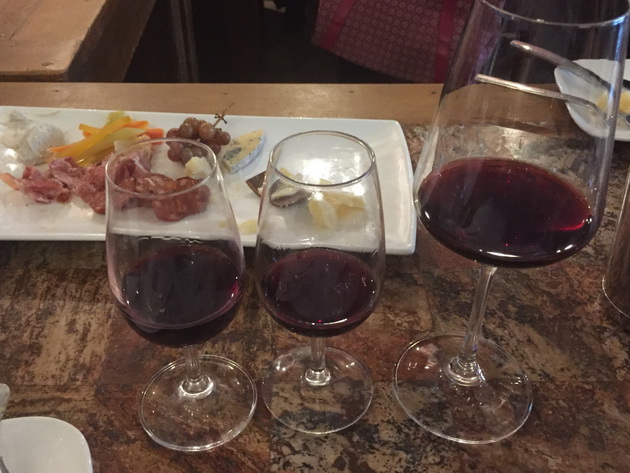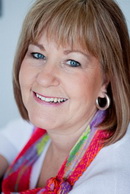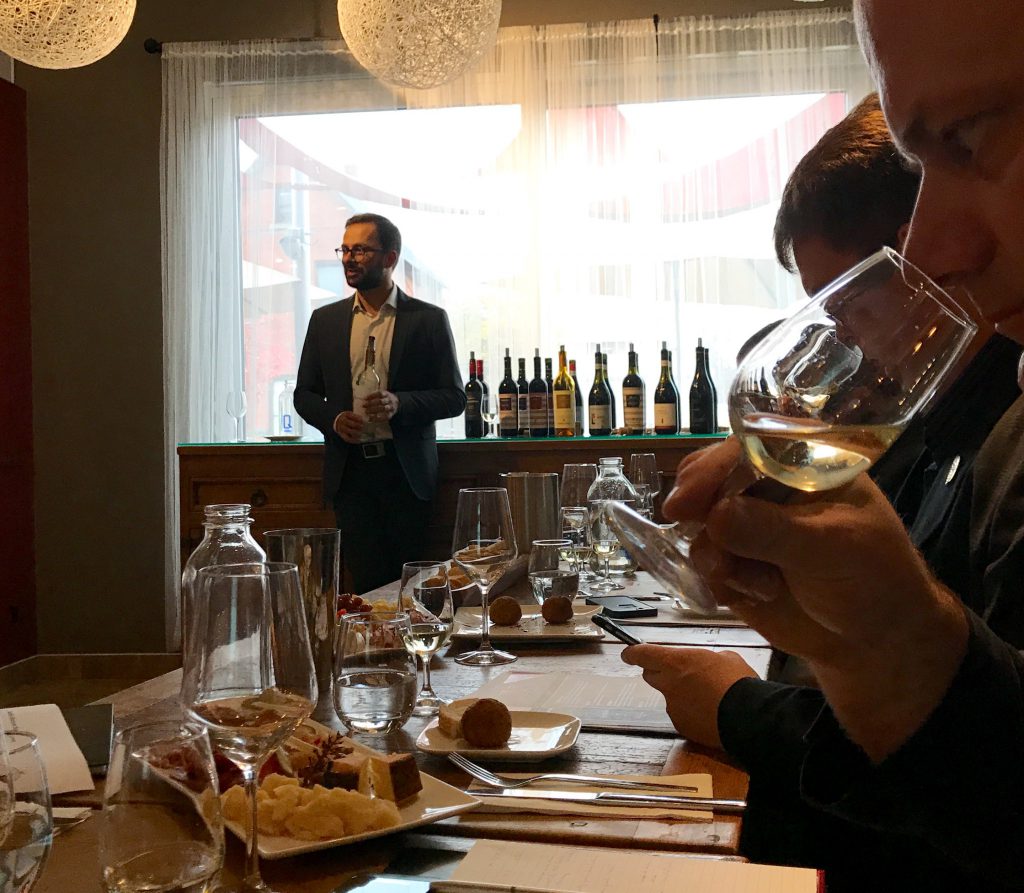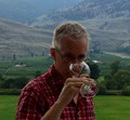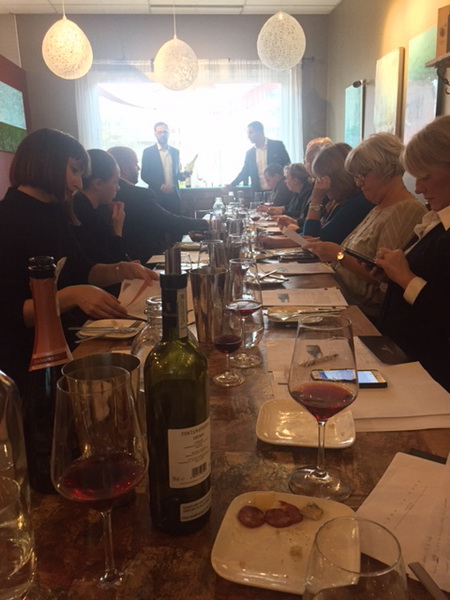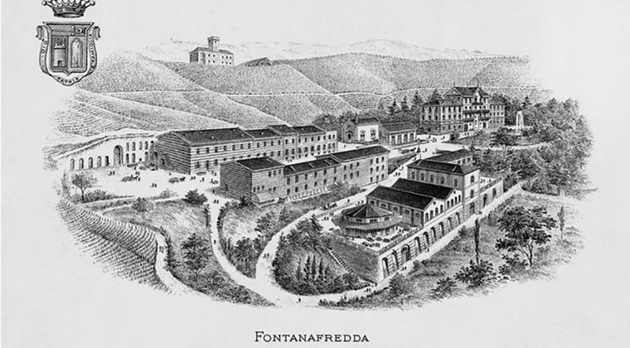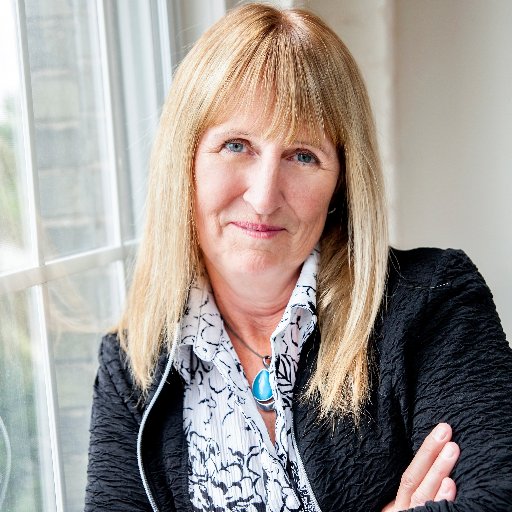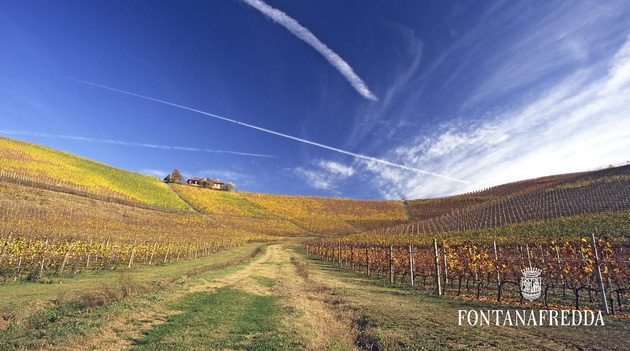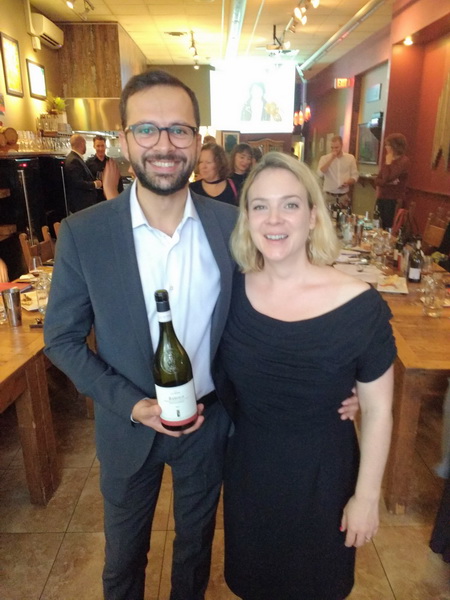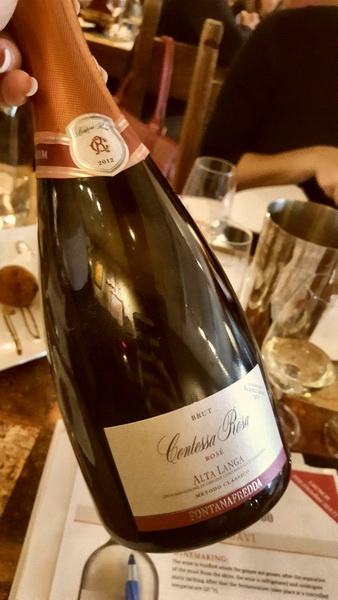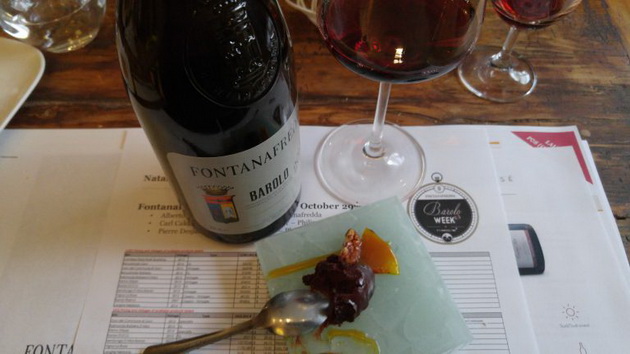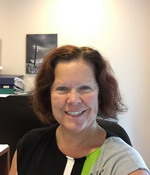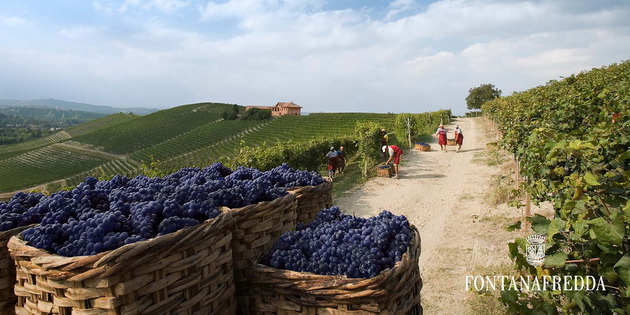Recently, Canada’s top wine writers and sommeliers gathered in our nation’s capital for a comprehensive tasting of the wines from one of Italy’s best wine producers, Fontanafredda. Here are our impressions and tasting notes.
Jennifer MacDonald Havers
Wine Columnist, Ottawa Citizen
The weather may have been rainy, but spirits were bright on a Sunday afternoon as we had the opportunity to celebrate Barolo and learn of one of the gems of Piedmont, Fontanafredda.
Alberto Frea, the brand ambassador for Fontanafredda, walked us through the extensive family history of the winery as well as some of the unique characteristics of the estate, surrounding land and the region, as we tasted some wonderful wines spanning the portfolio.
This historical winery – approaching their 160th anniversary in 2018 – is located in Serralunga d’Alba, in the heart of Piedmont. Recognized as a UNESCO World Heritage site, the winery is the largest continuous vineyard land in Piedmont, having never been parcelled out and all has remained as the Fontanafredda property.
Truly a community, the vineyard area is actually a village and home to many who work at the vineyard, and even the mayor of Serralunga d’Alba.
Piedmont is known for legendary Barolo and Fontanafredda has a most idyllic spot, evidenced by the hilly, picturesque vineyards gently sloping away from the estate in a valley formed by the sea millions of years ago. Piedmont literally means “at the foot of the mountains” which becomes evident when you locate Piedmont on the map.
The region is protected by the Alps to the North which provide an excellent barrier to frost. No place in the region is further than two hours from the sea. These factors create a unique and ideal microclimate, where warm and cool air collide. These ancient soils are layered and diverse, from chalky calcareous soil, to sand and limestone, each suiting different grapes to be grown.
Along with the “King of Wines”, Barolo, Fontanafredda also showcases Cortese (Gavi), beautiful estate Nebbiolo, Barbera, and even Pinot Noir and Chardonnay (for an awesome sparkling wine that uses a dosage of 1967 Barolo we sadly cannot get in Canada). Around 20% of their production is grown on the estate land, the rest coming from trusted growers around the region, all working to high standards and without the use of any chemicals.
Along with traditional single varietal wines, the winery is also exploring different blends to capture different varietal qualities. The Eremo wine from the Stripes collection is an example of this, blending Barbera and Nebbiolo. They have also produced wines to showcase different or more modern styles of Barolo by using shorter maceration times and smaller oak barrels for aging, producing a wine that still has the Barolo characteristics and potential to age, but is a more modern approachable style in its youth.
Fontanafredda is a wonderful showcase of traditional wines steeped in history and staying true to their roots, but still able to embrace modern trends and experiment in order to reach new fans. This shows in the range of wines and the high quality produced. The results are a dynamic portfolio with something for everyone.

Caitlin Coleman
Accredited Sommelier
It was a rainy and chilly Sunday in Little Italy, Ottawa, at a place called Divino Wine Studio that hosted Fontanafredda’s Brand Ambassador, Alberto Frea, along with our group to taste some outstanding Barolos, Barberas, Gavis and more!
Dating back to the 1850’s, Fontanafredda, meaning cold fountain, was purchased as a token of love and affection by widower King Vittorio Emanuele II for his mistress Rosa Vercellana, known as the Bela Rusin. She was but a commoner and hence could only be a mistress until the savvy Vittorio made her the Countess of the winery to grant her status. Quite the love story and the Bela Rusin is the namesake for my two favourite wines of the day.
Anyone who knows me is aware of my affinity for anything bubbly, especially something out of the ordinary. The Contessa Rosa Rosè is probably one of the swankiest aperitifs you could offer to a guest.
Approximately 70% Pinot Nero and 30% Chardonnay, grown in calcareous limestone soils, are harvested in September, gently pressed and fermented separately until Spring in stainless steel tanks. It is then that the two wines are united and undergo a secondary fermentation in the bottle and in contact with the yeasts to create a Classic Method Sparkling Wine.
This is where it gets interesting….. after disgorgement (removing the excess yeasts from the bottle) there is an expedition liqueur made of 1967 Barolo wine added to the mix. This results in a slightly pink coloured sparkling wine with a superior bouquet of orange blossom, ginger, sweet spice, lavender and cream. Somehow, you get a finish of minerality and lemon zest. Can’t you just taste it????
After an excellent start to our tasting, our host, Alberto, breaks our hearts telling us it was a tease and this wine can only be special ordered. Are you kidding me?
Now, on to the Barolos!!!
Fontanafredda has approximately 170 hectares of land in the Serralunga D’Alba which is located in the Italian region of Piedmont (foot of the mountains) and is one of the most prominent and respected areas to grow the distinguished Nebbiolo grape. Barolos are often described as rich in tannin and have a need to be aged. This is because, traditionally, the fermentation takes place on the skins for approximately three weeks, resulting in huge tannic wines that age in large wooden casks for years.
When the New World style of wines grew in popularity, those that prefer fruitier, earlier drinking wine styles, several producers began to cut fermentation times to a maximum of ten days and age the wine in small French oak barrels. “Traditionalists” have argued that the wines produced in this way are not recognizable as Barolo and taste more of new oak than of wine and called these new wine technicians the “Barolo Boys”.
Definitely a history lesson worth the google search and there is even a documentary telling the story “The Barolo Boys: The Story of a Revolution”.
This brings me to my favourite Barolo of the day, Vigna La Rosa 2012 (SKU#40105, $74.95, release date at LCBO March 1, 2018) the second of two wines named for the Bela Rusin. 25% of ageing of this wine is in new French oak barriques and the remainder in traditional style.
It represents the quality of the Barolos grown in Serralunga D’Alba at its best, there was something of a warm tannin and a touch of fruity characteristics that are usually absent in Barolo tasting notes. There is still the typical tar, rose and cigar box notes that one expects when drinking a wine of this nature, but it is mingled with this enticing flavour of red and black cherry. More please!
I could sincerely go on and on about Fontanafredda, the history, the earth, the vine and the wine, the stories are endless.
The one last thing I think worth mentioning is that in 2009, sustainability became a huge priority to the agriculture at Fontanafredda and even though they are not labelled as “Organic” here in Canada (due to different standards and qualifications), you are basically getting wines that are grown responsibly; no chemicals, no sprays and organically in Italy. There are many of these wines at your local LCBO in the General List including the Briccotondo Barbera and Gavi (SKU’s #372987 & #526707, both $14.95) and a delightfully inexpensive but high value Barolo (SKU#20214 $29.95).
Drink up and enjoy! Salute!
Fontanafredda Briccotondo Gavi
Piedmont, Italy

Andrea Shapiro
Accredited Sommelier
During the afternoon in late October, I arrived at Divino restaurant and wine studio, on Preston street in Ottawa’s “Little Italy”. It was an exciting opportunity to meet and greet with Alberto Frea, Fontanafredda’s wine ambassador. He was also joined by national brand manager Carl Caldareri and account manager, Pierre Desjardins.
We were introduced to this winery, located in Piedmont, and were blessed to gain so much insight into the exclusive regions of the Langhe and the municipalities of Serralunga d’Alba, Diano d’alba, Barolo, Alba, Rodello, Dogliani, Farigliano and Murinsengo of Northern Italy and the uniqueness that their vineyards, climate, soils and character bring into the wines that hail from these areas.
We were greeted with a special surprise sparkling wine, Contessa Rosa Rosé. Named after Fontanafredda’s original historical estate owner – Vitto Emanuele’s mistress, Rosa Vercellana. Alberto explained to us that, “Like all things that are beautiful, even Fontanafredda was born from a love story.”
This homage sparkling wine was done in the classical method, undergoing a second fermentation in the bottle. Made with Pinot Noir and Chardonnay, it has a small touch of 1967 Barolo added to it to give it that extra special light pink tint.
This was a delectable introduction to the story that was being told. It is not available in our market currently, which made it momentous that he shared that with us. He explained that, “every year, twenty bottles of aged Barolo are opened to make this sparkling rose, so it’s very special for us”. It was indeed, very special for us too.
We then engaged in a side by side tasting of two white wines, both made from the Cortese grape variety, which grow well in the Gavi region of Piedmont and pick up the ranges of unique terroir.
First, we tried the Briccotondo Gavi. Briccotondo, meaning “rounded hill“, lives up to its name with this crisp, bright wine. It is a new, recent addition to the LCBO on the general list as of October 2017.
It’s fruity and very well-rounded and congenial. Alberto states that they were looking to create something that would be approachable for a younger generation. He mentions, “Millennials can be scared of the bold wines and this helps to bring a slow introduction to Piedmont”. So making something approachable is important.
Aged in Stainless steel, it’s light pale straw colour show an element of elegant simplicity and is quite a good partner for seafood. Offering aromas and flavours of pear, yellow apples and fresh oceanic saltiness. Truly reflects the native terroir which is influenced by the sea.
In contrast, the Gavi del Comune Di Gavi wine was a little bit different. This one possessed a deeper colour and some larger aromatic richness and body. Notes of tree fruits, minerals and luscious vanilla peaches.
It is stated that, “this is a white wine with personality!” It certainly is just that and with the unique vinification methods used here including soft pressing and additional aging on lees make it a fresh white flavourful wine that is also very easy to pair with a variety of seafood and soft cheeses.
We were then pleased to engage in another back to back tasting with two Barbera wines. Also having a comparative, enjoyable analysis done side by side.
Raimonda Barbera d’Alba is made with Barbera grapes that are grown in the villages surrounding Serralunga d’Alba. Two parts of the wine are aged for about 12 months in different wood vessels. One, large Slovenian and French oak casks and the other small American and French barrels.
They are blended from each of these before being bottled. This type of aging brings nice rich and toasty aromas of blackberry, leather and chocolate with crisp echoing flavours. In contrast to the Briccotondo Barbera, it has a much lighter colour with rich refined flavours.
Briccotondo Barbera starting with a noticeable colour difference this one is a deep ruby color. The vines were grown on guyot in the Monferrato and Langhe region. Rich intensities of metals from here, due to the calcareous and sandy marley soil. Lots of blackberry, plum with sweet and peppery spices.
Each of these Barbera’s were different but they both complemented our charcuterie and cheese plate perfectly with special focus on the cured meats and salty aged cheddar.
Another stand out wine in the lineup was Eremo Langhe Rosso. A red DOC blend of 60% Barbera and 40% Nebbiolo from the Barolo and Barbaresco area. This blend changes with each vintage and 2014 was a rainy year, resulting in lower yields, but outstanding quality Nebbiolo.
A gorgeous medium garnet colour and what really took me by surprise, was the voluptuous bouquet coming from the glass. So fragrant!
Dark plum, ripe strawberry and violet floral elements. Dry and grippy with balanced rich tannins. Will make it to our market in March of 2018. I personally can’t wait to pick this up again!
An outstanding treat to finish us off was the Barolo Riserva. This was exciting and a definite highlight.
Nebbiolo from the Serralunga d’Alba region. Aged in wood for three years, and two more years in bottle. We were fortunate to pair this deliciously with a dark chocolate mousse prepared by Divino’s, Eric Diotte. It was absolutely delectable together!
And, what a nice colour. Rich ruby, vibrant and worth pause. Its definitely a pensive wine, where you want to drink it with good shared company, possibly after dinner with great conversation. Available in Vintages at the LCBO from the October 28th release.
An afternoon with Alberto’s tutelage of Fontanafredda and the regions that it hails from left us feeling like we had taken a trip to Italy and back all in one afternoon. Exquisite and educational.
Looking forward to what’s next from them and their new releases coming next year. Perfect, personal, Piedmont.
Fontanafredda Riserva Barolo 2007
Piedmont D.O.C.G., Italy
Colin McKone
Accredited Sommelier
On a rainy Sunday afternoon, I was invited by Natalie MacLean to join a winemakers tasting at the Divino Wine Studio with Alberto Frea of Fontanafredda Wines. One of the first things I learned was that next year, in 2018, Fontanafredda will be celebrating their 160th anniversary, an amazing feat especially when you consider that Canada is currently celebrating 150 years of Confederation.
The winery is in Piedmont (northwest Italy) surrounded by the Alps which offers its vines protection from the winds and provides a unique micro-climate to grow grapes.
It was recently designated as a UNESCO World Heritage Site and it has the Italian DOCG (Denominazione di Origine Controllata e Garantita) designation which means that the wine is of the highest quality and made under the strictest regulations. Another interesting fact we learned, from the perspective of a Canadian wine drinker, was that Fontanadredda has been exporting wine to North America since 1890.
Brand Ambassador Alberto Frea went over the interesting history of the winery and how it was established by Vittorio Emanuele II as a gift to his mistress, Rosa Vercellana, and was later handed down to their children. Vittorio Emanuele II was, apparently, quite the “ladies man” back in his day in a way it is safe to say he could not get away with today.
After a brief overview of the winery we got to try our first wine, a vintage sparkling wine, the 2012 Contessa Rosa Rosé, which was named after Rosa Vercellana. What makes this sparkling wine truly unique is that it gets its pink colour by mixing in 1967 Borolo. It is a shame that this delightful sparkling wine is currently not avaliable in Canada, yet (I hope that changes soon).
Next we got to try two of their white wines, 2016 Briccotondo Gavi and the 2016 Gavi di Gavi. Both of these wines are made with 100% cortese grapes with the Gavi di Gavi being the higher end of the two, but at $18.95 (compared to $14.95 for the Briccotondo) it is still a terrific value. Both were easy drinking wines with nice crisp acidity, I found that every sip made we want to try another.
After that we got to dive into the Italian Reds, starting off with two Barbera’s, specifically Briccotondo Barbera 2016 and Raimonda Barbera D’alba 2015. Now I must admit that I haven’t had many Barbera’s or Borolo’s outside of my sommelier classes which is a big reason why I signed up and was looking forward to this wine tasting. Both are an exceptional value and are terrific wines to pair with food.
Finally the moment we were all waiting for arrived and we got to try Barolo, what Fontanafredda is most famous for.
The highlight for me, out of the many outstanding Barolo’s we got to try, was the Serralunga D’alba Barolo 2013. Delicious, full bodied with complex flavours and aromas, a vintages release (in Ontario) but I’ll definitely treat myself the next time it is in stock.
Overall it was a very enjoyable wine tasting, I knew going in I was going to enjoy the Barolos and Barberas and they did not disappoint, however, the one big surprise for me was how much I enjoyed the white Gavi wines. If you are a lover of Italian reds, I would recommend stepping out of your normal comfort zone and try picking up a bottle, I think you will be pleasantly surprised.
Courtney Flood
Wine & Food Writer
On a cold and rainy Sunday, I was reunited with my love of wine tasting after a long hiatus to write the CPA exam, at this intimate affair hosted by Italian winery, Fontanafredda, at Divino Wine Studio.
The star of the show was Alberto Frea, Brand Ambassador for Fontanafredda. He excitedly clicked through slides full of photos of beautiful landscapes, timelines and history of the winery.
The winery is rich with history, as the estate was founded by Vittorio Emanuele II King of Sardinia in 1958, who then went on to became the first King of the united Italy. The King assigned his beloved commoner mistress, Rosa Vercellana, Countess of the estate so that they could be married.
The winery was not started until 20 years later, by Victor’s son, but the story stayed with the winery and two of the wines that we tasted that afternoon were named after Rosa.
The first wine was poured, sparkling (my favourite!). The aroma of crisp citrus zest and yeasty tang made my mouth water as the wine hit the glass.
I continued to listened patiently, eyeing my glass, swirling, and taking a couple of sniffs. Alberto went on to talk about the wine, the first to have the name of the beloved mistress Rosa. After several anxious minutes, I finally had my first sip – a burst of citrus, minerality and tickling bubble, with a hint of earthiness.
The wine is a mix of 70% Pinot Noir and 30% Chardonnay, but with a little something else. As it turns out, each bottle has a hint of 1967 Barolo added with the dosage.
Alberto explains that the winemaker tried several other vintages of Barolo, but 1967 was the one that added the right note of complexity that he was looking for. The retail price for this wine is around $40, but sadly it is not available in Canada.
Next, we were poured two white wines, Briccotondo Gavi and Gavi del Commune di Gavi (“Gavi di Gavi”). Both are made with the same grape, Gavi, but the styles are very different.
The Briccotondo is crisp, delicate, with a perfume of floral, while the Gavi di Gavi is rich with notes of ground cherry, mango, vanilla and a bright acidity that keeps it balanced. Plates of Arancini were passed around, and the warm, creamy inside and crispy salty outside paired nicely with the richness and crisp acidity of the Gavi di Gavi.
Briccotondo is available on the general list at the LCBO for $14.95, while the Gavi di Gavi is available through Vintages for $18.95 (next release date July 21, 2018).
Next, a side by side tasting of the Barbera grape, Briccotondo Barbera and Raimonda Barbera D’Alba. Both have a surprising amount of fruitiness for the type of grape, although the Briccotondo displays a sweeter jammy fruit and the Raimonda displays a brighter, juicy fresh fruit. Barbera can tend to be very earthy, unripe, and acidic.
Both are versatile food wines, pairing easily with pasta, chicken, pork, roasted vegetables, including the creamy hand-made gnocchi in Gorgonzola cream that we were served.
Briccotondo is available on the general list at the LCBO, also $14.95; and the Raimonda is available through Vintages for $16.95 with some bottles still available.
The next wine is my personal favourite of the night, Eremo Stripes. It is a blend of brooding Nebbiolo nicely balanced by the freshness of Barbera displaying plush berries, milk chocolate, and a note of violet. At $17.95, I am marking my calendar for the next Vintages release on March 18th, 2018.
We finished with five styles of Nebbiolo. We try one in a younger style (Langhe Nebbiolo) and four Barolos. The Langhe is warming, with notes of spicy ginger and cardamom.
The Barolos range from complex and savoury (Riserva Barolo 2007, Serraluga D’Alba Barolo) to plush and elegant (La Rosa Barolo, 2013). The flagship Barolo (2013 vintage), was a pleasant balance and a fantastic gateway into Barolo at only $29.95, general list at the LCBO. The other three Barolos range from $44.95 to $87.95, all available through Vintages. All pair wonderfully with the dark chocolate and beet mousse with salted caramel.
A big thanks to Fontanafredda, Divino, and Natalie for a wonderful afternoon full of wine, food, laughter, and familiar faces.
Fontanafredda Raimonda Barbera D’alba 2015
Piedmont D.O.C., Italy
Donna Hargrove
Wine Writer & Tasting Group Leader
What do you do on a dreary, rainy Sunday afternoon? Taste wine of course! On October 29th, I was fortunate to join a group of wine professionals for a tasting with Alberto Frea, the Brand Ambassador for Italian winery Fontanafredda. Hosted by Philippe Dandurand Wines at the Divino Wine Studio on Preston Street, the venue and subject combined for a most enjoyable and informative afternoon.
Alberto Frea, with his perfect Italian accent, was as interesting to listen to as the Fontanafredda wines were to taste. With a rich history that involves kings and mistresses, the Fontanafredda winery is celebrating it’s 160th anniversary in 2017. Coinciding with #BaroloWeek, our tasting included Rosé, Gavi, Barbera, a Nebbiolo/Barbera blend and of course Barolo.
The 2012 Contessa Rosa Rosè (70% Pinot Noir / 30% Chardonnay) was named after the original mistress of the estate. The surprise here was the addition of an expedition liqueur of 1967 Barolo. Of their annual production, 40% of their Barolo is saved in the winery, for uses such as this.
For the 2012 production, there were 20 bottles of 1967 Barolo sacrificed. The result was a fresh soft pink wine that is sweet citrus on the nose with a balanced acidity on the tongue, uniquely finishing with a hint of ginger.
What is Gavi? I’m glad you asked. Having never tasted a Gavi prior to this event, I was pleased to taste and learn about this wine. Gavi was a popular wine about 30 years ago and was Italy’s first white to gain international repute.
It is still considered to be the Piedmont’s most popular white. Made entirely from the Cortese grape, this wine is a well priced, delicious and on-trend white.
And how do you finish off a perfectly rainy Sunday afternoon, with not one, not two, but FOUR Barolo wines. Each one better than the last, the history and make up of each one, explained by Alberto, with a backdrop of photos of the breathtaking beauty of the Fontanafredda village, winery and vineyards. The Piedmont region in North Western Italy is one of the best regions for producing Barolo wines, and Fontanafredda is among the largest producers, with 6% of the total production (780,000 bottles per year).
The sweeping views of terraced vineyards bursting with fruit, along with Alberto Frea’s description of the area and it’s history, has cemented my resolve to visit this region of Italy. Of course, talk of a spa opening in the near future certainly helped.
I would be remiss if I didn’t commend Eric Diotte of Divino Wine Studio for his perfect pairings and welcoming venue.
Fontanafredda Nebbiolo 2016
Langhe D.O.C., Italy
Fontanafredda Contessa Rosa 2012
Alta Langa, Italy
Lynn van der Linde
Accredited Sommelier
A Regal Worthy Fontanafredda Wine Tasting at Divino’s Ottawa
Barolo, the “king of wines” has had an interesting history, and Fontanafredda winery has been along for the journey since the very early years. On a rainy Sunday afternoon in late October, in the cozy and aromatic Divino’s of Ottawa, Fontanafredda wine ambassador, Alberto Frea, took us on a tour of the senses with an incredible line up of ten wines.
The Contessa Rosa Rosé sparkling was the first taste of the day. With vines located on the high hills of Alta Langa, the terroir is perfect for growing Pinot Noir and Chardonnay, the two varietals found in this traditional method gem.
Heady floral orange blossom and lavender aromas fill the glass, with delicate, yet persistent bubbles from start to finish. What’s most interesting about this wine is the micro-inclusion of 1967 Barolo into the top-up expedition liqueur, which is what gives this bubbly its delicate pink hue.
Alberto confesses that legally someone has to be in the room when the ’67 is opened and added to each vintage of the Contessa. I guess 1967 was the year where a lot of Barolo was produced, enough to top up every sparkling Contessa – at least for now.
We then moved on to the white flight, consisting of the Briccotondo Gavi, and the Gavi di Gavi, both produced with 100% Cortese grapes. Cortese grapes have a history in Italy dating back to the fifteenth century, and is known for its ultra dry characteristics and crisp acidity; perfect with seafood and milder cheeses.
Fresh and vibrant, the Briccotondo shows lively citrus and green apple up front, with a bone dry mouth feel and a lingering apple finish. In comparison, the Gavi di Gavi has a fuller mouth feel than the Briccotondo as a result of some of the juice (15%) spending fermentation time in small barriques before being aged in stainless steel for another 2-3 months.
At $15 and $19, respectively, both of these whites are a lovely change from the “usual” whites found at the LCBO, while not breaking the bank trying something new.
The next flight poured consisted of two Barbera wines and one Barbera-Nebbiolo blend. The Briccotondo Barbera is the general list Barbera, and is a more fruit-forward expression of the Barbera grape, native to the Piedmont region of Italy.
The warmer climate, and concentrated fruit, along with the use of new French barriques for aging, encourage more of the fruit flavours to come through on the palate. By comparison, the Raimonda Barbera d’Alba is aged in larger barrels, with grapes grown in the slightly cooler Seralunga d’Alba region, imparting more earthy and tannic characteristics – eucalyptus, vanilla, and forest floor.
The Eremo is the fore into the Nebbiolo varietals, as it represents a 60% Barbera and 40% Nebbiolo blend, sourcing grapes from the Langhe region. Each varietal juice is fermented separately in small oak casks for eight months, and then blended and aged for an additional four months in larger casks. The result is an extremely sexy wine, brilliant red in the glass, aromas of coffee and chocolate with a zip of spice in the finish.
The final flight consisted of five Nebbiolo wines – the first as a Nebbiolo from Langhe, and the remaining as Barolos. I’m a huge Nebbiolo fan, and was so pleased to discover this Langhe DOC Nebbiolo.
An elegant yet traditional expression of the grape, it strikes the perfect balance between dark fruit and spicy notes in the glass and palate. With its release coming to the LCBO in early spring 2018, and reasonably priced at $20, I for one will be grabbing a case or two as a cellar staple.
As a little side note about the Langhe region, and something that I wasn’t aware of, in 2014, the region was named a UNESCO world Heritage region, and has attracted more and more tourists each year.
The last four wines were the royal – aka Barolo – tastes of the day.
Barolo was first modernized as a dry wine in the mid-19th century, using strictly 100% Nebbiolo grapes from the northern region of Piedmont-Langhe. Previously, Barolo was thought to have been more of a sweet wine, as it was one of the last grapes harvested when the grapes are at their sweetest. This new dry wine soon became the “king of wines”, and noble elixir for Italian royalty.
The grapes used to produce these Barolos are harvested at the end of the season in mid-October, resulting in more intense flavours and aromas – and each wine in this flight increased in this intensity (and price), and represent the best of the best expressions of the Nebbiolo grape.
The Barolo Tradition is the entry level, or general list of the group, aged one year in French oak to keep its structure and characteristics. Still fruit forward, but much more structure and intense aromas than the Langhe Nebbiolo.
In comparison, the “striped” Serralunga D’Alba bottle, with grapes grown strictly in its namesake region, is more earthy in both aromas and flavours as a result of the limestone soils. A wonderful mid-range Barolo, both in price and intensity, and a cellar staple for sure.
The Serralunga D’Alba region happens to be the largest producer of Barolo for the Fontanafredda winery, and this 2013 vintage represents the 25th anniversary of this wine. The striped label is a nod to the once striped buidings that housed the first kings of Italy in the mid-19th century.
Going up another rung on the Barolo scale, the Vigna La Rosa Barolo boasts a bolder, spicier expression of this wine. Using grapes grown in the south-facing, clay soils of the La Rosa vineyard in the highest part of the Serralunga D’Alba region, one can see why this wine was reserved for royalty.
The final Barolo represents the best of the best, but Alberto reminds wine enthusiasts to patiently cellar this one for at least 10 years.
Fortunately, we cracked this 2007 vintage at the perfect time! Richer in colour and aromas – vanilla, eucalyptus, white pepper, and that beautiful overtone of violet transforms into a balanced mouth feel and a lasting spicy finish.
A wonderful holiday gift for those Barolo lovers in your circle!
From its beginnings in the mid-19th century to today, Fontanafredda continues to create “royal-worthy” wines that both stand the test of time and allow for the rest of us to just feel like royalty, even on a rainy Sunday.
Mary Anne Van Gaal
Wine Tasting Club Leader
The October 29, 2017 team tasting of Fontanafredda wines at DiVino Wine Studio was both informative and tasty. Alberto Frea, the Brand Ambassador for Fontanafredda, was a fountain of information. He handled any question thrown at him with ease and clarity making it an outstanding event.
Fontanafredda has quite the 160 year old history, involving kings and mistresses, bankruptcy, vineyard destroying disease and the first vineyard of the Barolo grape. Barolo, the “wine of kings and the king of wines” was made a legend by Fontanafredda. The actual location of the winery was even declared a UNESCO World Heritage site in 2014, it is that valuable a piece of history.
 Photo: Mary Anne van Gaal (from Fontanafredda literature)
Photo: Mary Anne van Gaal (from Fontanafredda literature)
The winery is located in Piedmont, an area at the top left of the boot that symbolizes Italy. Wedged between the Alps and the sea, a unique microclimate exists to influence the quality of the grapes. The mountains protect the vines from the winds and the sea has produced soils that have unique layers of limestone and sand, especially well suited for white wines.
 Photo: Mary Anne van Gaal (from Fontanafredda literature)
Photo: Mary Anne van Gaal (from Fontanafredda literature)
Piedmont is all about single grape varieties, so they have very strict rules for wine making and standards. In 2009, the banning of chemicals began, and Fontanafredda hopes to have organic certification by 2019. Land is so expensive in the area that, in order to expand, wineries need to buy grapes from local “trusted” families.
With Barolo such a big part of their history, Fontanafredda is marketing Barolo month as a way to introduce this great wine to the masses. They also produce a Barolo Tradition at a great low price point without sacrificing any quality. The focus is on getting accolades rather than profits for this particular wine. Fontanafredda must be doing something right as they are nominated, and short listed, for the top winery in Europe and are the only Italian representative. If the wines we enjoyed in this tasting are any indication, they have a great chance of taking top honours!
Matt Steeves
Wine Expert, CTV Morning Live
The King of Italian Wines visits Ottawa for a unique tasting of some of Piedmont’s finest.
Recently a group of Ottawa-based wine writers and sommeliers had the opportunity to attend a portfolio wine tasting from a very storied Italian winery, Fontanafredda, from Piedmont, Italy. Fontanafredda’s story begins in the most storybook of ways, having been founded in 1858 by the then King of Italy, Victor Emmanuel II, who was the first king of a united Italy since the 6th century.
As one may expect, there’s a very intriguing love story that sets the stage for the King’s debut into premium wine making, and how his mistress, La bela Rosin, was named Count of Mirafiore and Fontanafredda to enable some interesting extra curricular activities, which would then enable the creation of one of Italy’s most storied wineries.
Fast forward 159 years, and pop over to Canada’s capital, Ottawa, where we were able to taste a full flight of some of Piedmont’s most famous wines, including the impressive ‘Barolo’, which is renowned as “The Wine of Kings, and the King of Wines”.
Barolo is produced from the Nebbiolo grape, which to me and many, is so intriguing given its paradox of super light ruby/garnet colour but with huge structure, texture, and flavour. We were fortunate to get to taste the full portfolio starting with their gorgeous Contessa Rosa Rosè traditional method sparkling wine that includes a splash of 1967 Barolo as part of the dosage. The ‘splash’ of Barolo was also added to a few of their ultra value priced whites and reds, such as the delicious Gavi de Gavi (white wine made with Cortese grapes).
A remarkable find for me, at $17.95, was the Eremo which is a blend of Barbera and Nebbiolo, combining the best from Piedmont. Mark your calendars for March 2018 when Eremo hits the shelves of LCBO… it’s literally a back up the truck and load up wine that I’ll be buying at least two cases if not more.
We tasted the delicious Barolo wines, including the ultra value priced Fontanafredda Barolo DOCG which sells for $29.95 at LCBO (I know, seriously!!!). That ultra value priced Barolo was delicious, with such a fragrant bouquet and lovely texture which complemented beautifully the hand rolled Gorgonzolla blue cheese gnocchi we paired with it.
From that beautiful Barolo we then tasted their more premium reserve Barolos which were outstanding. The Serralunga D’Alba Barolo is being released in Vintages on April 29, 2018 at $44.95 and it’s a stunning wine (92+ points), and the single vineyard Vigna La Rosa will be available via Classics on March 1, 2018 at $74.95.
Terrific wines to pick up for your cellar, or gift for Mother’s/Father’s Day next spring. I highly recommend tasting the wines from this storied Piedmont winery and enjoying them throughout the year with a wide range of dishes.
BBQ, hearty stews, pasta, and cheese all pair beautifully with their reds. Check them out next time you visit the LCBO in the Italy section. Cheers! Matt Steeves – www.quercusvino.ca
Sean O’Regan
Director, National Capital Sommelier Guild
The close of October brought another occasion for several local Ottawa sommeliers and wine writers to attend a Fontanafredda portfolio tasting led by Alberto Frea, Brand Ambassador for Fontanafredda at DiVino Wine Studio in Ottawa’s Little Italy. What better way to spend a cold rainy afternoon than learning the history of the estate and listening to stories of kings while tasting wines.
Fontanafredda estate is located in the hills of the Langhe region of Piedmont in Italy, and is the largest adjoining estate in Barolo. The estate has a long and storied history; originally used during hunting trips to change horses at the stables.
In 1858 King Vittorio Emanuele II, decided it would be a good place to plant Nebbiolo for making Barolo. Vineyards and cellars and new buildings were constructed to produce wine for the King and his family. It was his son Emanuele di Mirafiore, however, that brought the wines to the world after the king’s death in 1878 after establishing the E. Mirafiore winery at the estate.
Ahead of his time in thinking, and a skilled winemaker, Emanuele di Mirafiore opened the market for the wines from royal family to wine connoisseurs and enthusiasts. In 1887 the estate was opened to the public as a wine tourist’s destination – one can only imagine a wood fired pizza oven to accompany wine tastings.
Emanuele had also entered his prized Barolo into local and international competition to great acclaim. By the end of the nineteenth century, Mirafiore was being exported globally. The winery hit its peak in the early twentieth century, then run by Emanuele’s second son Gastone, before a decline into bankruptcy following WWI, phylloxera’s devastating blow to vineyards across Europe and the Great Depression.
With many ups and downs over its history, Fontanafredda today appears to be back on an upward swing since new ownership in 2009 with focus on quality, sustainability and environment. Fontanafredda was the first vineyard in Piedmont to be officially recognized for sustainable viticulture in 2009.
The Barolo’s being produced today by Fontanafredda hit a nice balance between the traditionalist and modernist styles that fueled the Barolo Wars in the 1980s. Modern techniques, medium long maceration times and use of large casks for aging, attempts to hit the Goldilocks zone of winemaking for consumer demand with great results.
Interesting to learn that the easily recognizable striped pattern on the bottles of Fontanafredda’s “The Stripes” line of wines (seen below) is inspired as a reflection of the contrasting lines between vines and calcareous soil in the vineyards and the painted stripes on the iconic buildings of the estate.
Products available at LCBO or SAQ or can be ordered through Philippe Dandurand Wines
Products available at LCBO or SAQ or can be ordered through Philippe Dandurand Wines.
Fontanafredda Gavi Di Gavi 2016
Piedmont D.O.C.G., Italy
Dr. Simon Chen
Accredited Sommelier
We got together on a Sunday afternoon to taste the wines from one of the oldest wineries from Piedmont, The Fontanafredda. The winery started in 1858 and next year, they will be celebrating their 160 anniversary (pretty amazing eh?).
It is not only a winery but it also has a hotel and restaurant on site so if you ever visit Piedmont, for sure to visit them and stay for few days. We had the honor to meet with their Brand Ambassador, Alberto Frea, who shared many stories about this historic winery and explained the different vineyards that they have.
Fontanafredda has seven series of wines that range from $10 to $100, and from my understanding, that is pretty unique in Piedmont. They have the ‘Sparkling wines’, the ‘Briccotondo’, the ‘Silver Label’, ‘the ‘Stripes’, the ‘Barolo Livgna La Rosa’, the ‘Library Collection’ and finally the ‘Barolo Riserva’.
For this tasting, we tasted 12 wines from these series and I have to admit that even their entry level series, the “Briccotondo’, is fabulous and approachable. We started with their Contessa Rosa Rosè, which is not available in Canada; however, I truly wish we’ll be able to get it one day.
Classic Champagne method, a blend of 70% Pinot Noir and 30% Chardonnay. The rosè has a beautiful toasty, oak, brioche aromas. The bubbles are lively and long, and on the palate, the pinot noir gave the dryness and medium acidity. A great sparkling wine to start off the tasting.
We then moved to tasting two white wines. Both are Gavi di Gavi, but one is in the ‘Briccotondo’ series and the other one is in the ‘Stripe’ series.
I’m not too familiar with white wine grape varietals from Piedmont but I learned that Cortese is actually the grape varietal behind the wine Gavi di Gavi. It’s aromatic, crisp, and good initial peachy fruit and dry mineral finish.
I like the Gavi from ‘Briccotondo’ better because it has a brighter acidity; however, the Gavi from the ‘Stripe’ is more rich and buttery, and it is better when paired with seafood stew or more oily fish.
After the whites, we tasted two Barbera from the ‘Briccotondo’ and the ‘Stripe’ series. Sometimes, Barbera can be thin and acidic but I was very impressed by these two. They have ripe dark berries fruits, good body but not complex.
In general, I like the ‘Briccotondo’ series more, and sitting at $11-13 a bottle, this is a very good deal.
Next, we moved to the big boy, Nebbiolo. The first one we tried, which I was very impressed with, is their Langhe Rosso ‘Eremo’ from the ‘Stripe’ series. Eremo is a blend of Barbera and Nebbiolo. This unique combination gave the wine a rich body, followed by a clean, dry tannin from the Nebbiolo.
We then tasted three Barolos at four different price ranges. 2013 Barolo from the ‘Silver Label’ is at $29.95. I’m not a big fan of this one as I find the wine is a bit hollow on the mid-palate, and generally too tart and tannic.
The second one was also 2013 from the ‘Serralunga D’alba Barolo’ in the ‘Stripe series’. At $44.95, this is a good steal from Barolo. Bright cherry, red fruits aromas. On the palate, it has smooth acid and long lingering tannin. A new-world style Barolo that is ready to be enjoyed.
The third Barolo was from the ‘Vigna La Rosa’ series. This 2012 Barolo at $74.95 offers quality and aging potential. It’s big and dry and at this point, the tannin is still a bit harsh. However, there’s enough fruits and acid to let it age for 10+ years.
Lastly, we had the luxury to try their 2007 Barolo Riserva. This wine is savory, smoky, and plummy. It is rich and dense on the palate and the tannin is still going strong. On the info sheet, it says the wine will reach its peak in 6-8 years but I think it can be stored easily for another 15 years.
Last, to mention, the great chef at the Divino Wine Studio make a beautiful gorgonzola cheese gnocchi to pair with the Barolo, and it was simply amazing. The rich and saltiness from the blue cheese complement the Barolo’s tannin very well.
Lori Kilmartin
Accredited Sommelier & Wine Writer
What’s Old is New at Fontanafredda Winery
I recently had the pleasure of attending a tasting of Fontanfredda wines with Natalie and my peers, led by the winery’s Brand Ambassador, Alberto Frea of Italy.
While the Fontanafredda Winery in Piemonte will be 160 years old in 2018, they are not resting on their laurels of being one of the largest most successful wineries in northern Italy. Steeped in history they are continuing to make wines in the tradition they have become famous for, but are also changing with the times.
In 1858 King Vittorio Emanuele II bought the Fontanafredda Estate as a gift for his mistress Rosa Vercellana. It was their son Emanuele Alberto di Mirafiore who made the Barolo wine famous before his death in 1894.
Even then he was ahead of the times and quite an entrepreneur as he developed the Estate into a village for the winery workers and their families. At one time 200 employees and 40 families worked and resided there. The village was self-sustainable and even had a church and a school.
Over the years the winery continued to make a name for itself making wine with Barbera, Dolcetto, Moscato and Nebbiolo, grown exclusively at the winery. Given this was only 20% of the yearly requirements, they also sourced and continue to source wine from local growers that have met their strict standards for quality.
They are one of the biggest producers of the famous Barolo Wine – the “Wine of Kings – King of Wines” producing approximately 780,000 bottles per year.
In 2008 the winery was purchased by a businessman who grew up in the region and is passionate about the land and its wines.
Oscar Farinetti owns 32 percent in Fontanafredda and his partner, Luca Baffigo Filangieri, another 32 percent. The remaining 36 percent was purchased by the Monte dei Paschi di Siena Foundation.
Farinetti is also known as the owner of “Eataly” which is a large Italian marketplace comprising a variety of restaurants, food and beverage counters, bakery, retail items, and a cooking school. The original location was in Turin but there are now several around the world.
What I find interesting is that since then they have taken steps to ensure that certain wines are still made in the traditional method, such as the Langhe DOC Nebbiolo which has the original label, but they have also have developed a line of more approachable and ready to drink wines under the Briccotondo label at a very attractive price point.
And even more interesting (and delicious) was their sparkling rosé “Contessa Rosa” made in the traditional method with Pinot Noir and Chardonnay that has a dosage of Barolo from their 1967 Vintage!! 20 cases are set aside from this vintage each year for this use alone.
While they strive to continue in their tradition of producing wines that “have linked generations down through the years”, in 2010 Fontanafredda also opened up the Estate to the public for tours where people can visit and learn firsthand about the winery and famous wines of the region. As well, in keeping with the current demand for more organic wines they have banned pesticides since 2009 in their vineyards.
Clearly Fontanafredda is doing a great job of continuing with the old – but at the same time bringing in the new!
Melanie Lloyd
Accredited Sommelier & Writer
What a treat it was to participate at the Fontanafredda wine tasting event held at Divino Wine Studio on October 29. Our guest speaker, Alberto Frea, the brand ambassador at Fontanafredda, gave us a wonderful presentation, complete with a slideshow.
Alberto was both informative and charming. He had a nice sense of humour and had us laughing frequently.
Divino Wine Studio offered a beautiful venue for this event. For those who have not been, it offers a warm and cozy atmosphere. The large white circular pendant style chandeliers add an artistic flare to the room.
The food was delicious and well matched for the wines that we tasted. This included a charcuterie board of dried sausage and Italian cheeses, fluffy fresh gnocchi, and a chocolate mousse to die for!
It’s an exciting time at Fontanafredda. They were nominated for top European winery of the year through Wine Enthusiast. They will know within the first few weeks of November if they won. Also, Fontanafredda will be celebrating their 160 year anniversary in 2018, the oldest winery in the Piedmont region.
Fontanafredda has an interesting past. In 1858, the Fontanafredda estate was bought by King Vittorio Emanuele ll. He bought it as a gift for his mistress, the Countess Rosa Vercellana who eventually became his wife.
Later, the estate was handed down to their children. Their son, Count Emanuele Alberto of Mirafiore contributed to the success of Barolo wine and was responsible for building the village around Fontanafredda.
The Fontanafredda Estate is located in the beautiful Langhe region of Piedmont. Alberto’s slideshow contained some breathtaking pictures of the landscape found in the area.
I learned that as of 2014, Langhe, along with Roero and Monferrato, was added as a UNESCO World Heritage site. This is a first for a viticulture designated landscape.
The region where Langhe is located used to be a seabed 14 million years ago. The soil is made of various compositions and we can find lots of diversity within short distances.
Although the soil is mainly calcareous, we can also find soil that has more sand, or soil with more loam or clay. Because of the age of the land, there’s lots of layers. Towards the center of Langue where Barolo wine is made, the soil has a first layer of sand, then a second layer of clay and marls. This soil contributes to the elegance of the wine.
The climate is continental. The precipitations occur mostly in the spring and fall and there’s great variation from year to year. This means diversity from one harvest to another.
Piedmont is surrounded by the Alps. This protects the land from the cold frost. This protection is especially beneficial right now, when we look at climate change and what happened last spring, for example, with the frost in Champagne.
I enjoyed every wine we sampled. We started with the wonderful Contessa Rosa Rosé Sparkling 2012, made using the champenoise method and named after the Countess. It is, unfortunately, not available in Canada, but was absolutely delightful with aromas of brioche, orange blossom, berries, as well as citrus on the palate.
Alberto explained that the Fontanafredda Langhe Nebbiolo 2016 was made in the traditional Barolo style. He referred to this type of wine as Barolo Classico.
The wine was lovely. It had a nice complexity with lots of ripe fruit, mostly cherries, as well pepper and floral notes.
The vinification and aging process of this wine is less lengthy than with Barolo, which is also made from the Nebbiolo grape variety. With Barolo, the wine ages for several years in contrast to less than a year with this Nebbiolo.
I thoroughly enjoyed all the Barolo we sampled. The slogan ‘King of Wines’ is very suiting to such a powerful yet elegant wine. It is no surprise that Vittorio Emanuele II would give Barolo as gifts.
The wine, generally speaking, has lots of berries, spice, underwood, and floral notes. The tannins are structured yet well integrated with good acidity and a nice finish.
Here’s a few notes on some of the specific Barolo I sampled.
The Fontanafredda La Rosa Barolo 2012, was aged in new French barriques. It had a certain delicateness.
It had aromas of ripe blackberries and raspberries, dates, spice, and underwood. I detected a touch of marmalade, an aroma I usually do not associate with red wine, yet it added to the complexity of the wine.
The Serralunga d’Alba Barolo 2013 was earthy and had lots of texture due in part to the ancient soil it came from. It had dark fruit, dried leaves, and lots of underwood aromas with a touch of vanilla, honey and sweet spice.
As a final note, Fontanafredda has launched Barolo week, a global initiative that includes Canada. With the high quality of their Barolo, Fontanafredda is the perfect winery to launch such an initiative!
The quality of all their products will have me buying and recommending their wine. I was very impressed!
Rachelle O’Connor
Wine Writer & Competition Judge
A rainy afternoon in downtown Ottawa welcomed a tutored tasting with Alberto Frea from Italy’s acclaimed Fontanafredda Winery. DiVino’s Wine Studio on Preston Street, with Chef and Owner Eric Diotte, crafting up his delicious morsels, provided the perfect venue for the intimate and detailed storytelling by Alberto about the history of the winery, supplemented with the sampling of carefully selected Fontanafredda wines.
Fontanafredda is located in the heart of the wine-growing region of Piedmont, within the sprawling hills of the Langhe. A world-class leader in the production of many of its wines, Fontanafredda is a large-scale winery with a great story, rich in history, spanning centuries.
Fontanafredda showcases pristinely cultivated vineyards by those who eat, breath and sleep wine. The landscape is outstanding, picturesque without a fault; the history is rich, as are the wines. Those who play a part in the crafting of these wines boast a shared, invigorating passion and appreciation for the beautiful land, the dedicated people and the polished, end result.
The winery planted its roots in 1858, set by King Victor Emmanuel II, and through changes in proprietorship from Counts and Countess’, legalities and transfers, the history of Fontanafredda had begun. The Count of Mirafiore in 1878, with his modern vision, began to take crafting wine, specifically Barolo, very seriously – a business was born.
Today, the grapes that are planted and plentiful in the vineyards are Nebbiolo, Barbera, Dolcetto, and Moscato. Barolo has become synonymous with Fontanafredda, premium wines crafted from the Nebbiolo grape – a thin-skinned smaller grape, generally yielding wines with higher tannins and acid.
Those “oh so familiar” aromas of tar and roses also give it away, while retaining an incredible ability to age well in the bottle. At Fontanafredda, the winery is opened to visitors year round – they welcome close to 40,000 people per year!
As we weaved through our list of beautifully crafted, elegant wines there were a few notable entries. The sparkling, Contessa Rosa Rosè (fittingly named after the mistress of Vittorio Emanuelle II) a blend of 70% Pinot Noir and 30% Chardonnay was uniquely fresh and complex, encapsulating both the history and the terroir. Interestingly enough, a new method had been undertaken in the creation of this cuvée, using an expedition liqueur with a 1967 Barolo, resulting in the slightly rusty pinkish hue.
The magical ride through “Barololand” ensued, it was captivating and we did not want it to end.
The Nebbiolo grape is nothing short of spectacular. These wines are elegant with intertwining luscious layers, developing at their own pace, over time. Many can age up to ten years, while some peak at 6-8 years, some much longer. The hand rolled gnocchi in a gorgonzola sauce was melt in your mouth perfection and the ideal match to the wine.
All in all, there was a constant throughout the afternoon… and that was Alberto’s ability to convey the concrete appreciation and recognition of the rich history of Fontanafredda and how it has shaped the present; coupled with a relentless and unwavering commitment to be a leader in modern development through trials and experiments with a pivotal role stemming from nature and history at the foundation.
Fontanafredda Briccotondo Barbera 2016
Piedmont D.O.C., Italy
Eamonn Donnelly
Accredited Sommelier & Writer
I was recently fortunate enough to join a wine tasting team tasked with analyzing a diverse selection of wines from Fontanafredda, a producer of fine wines specializing in Piedmont varietals. The tasting was conducted by Brand Ambassador Alberto Frea, a charismatic, charming individual who displayed a willingness to teach in a humbling and passionate way.
Both human and natural winemaking factors were highlighted, shedding light onto the importance of terroir, climate, and aspect, as well as cultural and historical implications influencing Fontanafredda specifically. By providing historic context prior to the consumption of any wine, it forced tasters to be critical and appreciative of how that wine evolved, and was shaped into the delicious product we all love.
This appreciation of history was inspirational. It evoked a sense of purpose one could connect with. Before a single wine had been tasted I knew we were in for a treat.
Fontanafredda originated in 1858 as a hunting lodge in Serralunga d’Alba. The property was purchased by Vittorio Emmanuele II as a gift for his mistress Rosa Vercellana. The Fontanafredda hunting lodge had exceptional land for grape growing, where acres of Nebbiolo would later be planted.
At the time, members of Piedmont’s landed gentry were expanding agricultural practices with a focus on viticulture. A newly developed wine had recently been created and others wanted to emulate it’s unique style.
Camillo Benzo, Count of Cavour, was a political statesman in Piedmont who played an important role in Italy’s movement toward unification. After the French Revolution, Napoleon exported his Army and quickly conquered Belgium, the Netherlands, Switzerland and most of Italy, making a series of puppet states.
During French occupation, Piedmont became an integral part of French territory. The lands were subjugated and redistributed, often to French or Austrian expatriates. Camillo Benzo’s parents were both of French origin who held a close relationship with Napolean. Michele Giuseppe Francesco Antonio Benzo, fourth Marquess of Cavour and Count of Isabella, Baron of the French Empire, was Camillo’s father.
During Napoleonic rule, the family inherited a large amount of land in Grinzane, which he later developed into vineyards. Camillo Benzo hired Frenchman Louis Oudart as his oenologist. Oudart assisted with winemaking in the region and is credited with creating the first modern Barolo, a powerful red fermented fully to dryness.
This particular style caught the attention of Italy’s reigning dynasty, becoming incredibly popular. It is both interesting and ironic that Italy’s “King of Wines, Wine of Kings” was largely impacted by a Frenchman from Champagne.
The history of Barolo, and how modern winemaking influenced the style had a unique impact on the Fontanafredda hunting lodge. Vittorio Emmanuele II, owner of the estate, was King of Sardinia and Piedmont.
In 1852, Emmanuelle II appointed the Count of Cavour as the Prime Minister of the region. Together they became the symbol of ‘Risorgimento’, the Italian unification movement. The connection between the two political figures impacted the future of the Italian identity, but also influenced the importance of winemaking in Piedmont.
The expansion of vineyards, a focus on single varietals, French ideology, and modern Italian winemaking techniques popularized Barolo. By 1878, Count Emmanuele Alberto di Miafore, son of Emmaneule II, developed Fontanafredda into a winemaking village. On premise was a church, a school, and housing for the well trained salaried workers. Under his guidance, Fontanafredda makes Barolo a legend.
Today, Fontanafredda specializes in showcasing Piedmontese varietals. Fontanafredda strives to produce wines that show the diversity of terroir, climate and winemaking technique in Piedmont, and specifically, in Serralunga d’Alba.
Maintaining tradition is critical to the success of Fontanafredda, and through their wines one can appreciate attention to detail and the history that brought them success.
Greg Hughes
Wine Writer & Sommelier
Of all the houses in Barolo to be able to experience in a sit-down tasting, it was a stroke of luck to have it be Fontanafredda.
Not only are they historic, but they’re an excellent example of older tradition and more modern styles.
Decades ago, the difference between the traditionalists and modernists was a controversy that bitterly divided the region of Piedmont. The old guard (still honouring their family’s production methods and using large Slavonian barrels) resented the erosion of tradition that would occur if modernists (many switching to French barriques for earlier drinkability and density) turned away from their history for market success.
Since the dust has settled, many producers lay their claim to one side of the dispute or the other, but some clever producers, like Fontanafredda, embrace their history and preserve their style, but also continue to innovate and pay attention to the lessons in modern winemaking taught by the band of misfit revolutionaries (often called the Barolo Boys).
Fontanafredda’s regal history begins under the ownership of Vittorio Emanuele II, the King of Sardinia, who assumed the throne of Italy and reunited the country.
The distinctive coloured stripes seen on several of the wines could be seen painted onto the sides of buildings at the estates. It was basically a way to be very clear, and warn those, far and wide, that it was Royal property.
The king was a Savoy and he moved to Piedmont. Torino (Turin) was the royal city of Italy.
Barolo was highly prized amd often used as a gift in the courts of Europe. Many people remember the moniker, “Barolo is the wine of kings and the king of wines.”
Fontanafredda was also served at the wedding of King Vittorio. His love life was the worst kept secret at court. Vittorio had lots of offspring. He was a notorious philanderer. Father of Italy, maybe; the father of lots of Italians, definitely.
Much of the Fontanafredda history involves Rosa Vercellana, his mistress. He was not allowed to marry her. She was not allowed in court because she was a commoner.
Fontanafredda was given to her and she became the first Countess of Mirafiori and Fontanafredda. She would never be granted the title of queen, but she did marry him in an official ceremony in 1877.
Fontanafredda still uses the original label on their barolo from the label designed by Vittorio’s son, Emanuele Alberto, who turned the estate into a commercial winery.
Gastone, Emanuele’s son, was a lot more like his grandfather. He was a philanderer amd apparently went bankrupt. He had to sell the winery and history has not really been very kind to him.
Yes, his habits may have been partially responsible for the fate of the house, but this is also the time of the philoxera vine plague and the depression, which destroyed many vignerons (philoxera being a vine pest that devastated the world’s vineyards in the late 19th century). Not even the wine of kings was safe from these serious issues of the time.
Up until that time, the wineries of Fontanafredda were tiny, self sustaining enclaves. The King paid for the education and housing of those who lived on the estate to make the wine. There were doctors, tobacconist, and grocers. It was indeed a small village.
Two wines of particular interest from the tasting were the Contessa Alta-Langa Sparkling and the Serralunga Barolo.
Alta Langa, where the Contessa comes from, has similar soil to the Langhe, but maybe older. It has perfect growing conditions for Chardonnay and Pinot Noir. It is traditionally made, it seems, still using pupitres and manual remuage. It sees a minimum 30 months on the lees and it must always be vintage dated.
It is mostly Pinot Noir so as to preserve the bracing mineral/acidity combo that reminds you this was made in Piedmont, where texture plays such a vital role in a wine’s structure.
There is a small dosage of Barolo 1967 in the sparkling. A legal representative must be present to certify that they did indeed use the ’67, since it is declared on the label. They must have tremendous reserves of this wine available to incorporate it so much. What will they do when it runs out? Begin trials with different vintages, one might suppose.
It is not available in Canada yet because it is hard to promote. The market for traditional sparkling in Italy is dominated by Franciacorta and Trento, though this is changing slowly.
 Photo: Greg Hughes
Photo: Greg Hughes
It was asked during the session, whether there was a particular amount of residual sugar in the 1967 that made it work as a dosage liqueur.
Consistent temperature, fermentation, and storage were difficult to maintain back then. Only slowly were modern technologies being employed. Sometimes uncontrolled fermentation would result in a very different wine.
The second wine of interest, the Serralunga Barolo was conceived as the first township level Barolo, in 1988. It has the stripes that the Fontanafredda sported in their regal days, though its style is more modern.
Of the Barolos in their profile, this is one of the few that sees French barriques. Much of the wine is still matured in the big Slavonian barrels, however. This makes this wine something of a bridge from tradition to newer styles. It delivers an expansive palate and aromatic profile, but never compromises on what gives Barolo its identity.
It was a pleasure to taste these wines and I would like to extend my gratitude to Alberto Frea for sharing the history of Fontanafredda and educating us about the wines of Piedmont.
I would also like to thank Carlo Caldereri and Pierre Desjardins, from Phillipe Dandurand Wines, for putting this event together for us.
Pamela Hatton
Accredited Sommelier & Writer
Fontanafredda is a scandalous love story with a wine side bar. The married king, Vittorio Emanuele II King of Sardinia, fell madly in love with the very young commoner, Rosa Vercellana, also known as “La Bela Rosin”. She became his mistress and had two of his children.
After the King’s wife died in 1855, he named Rosa Countess of Mirafiori and Fontanafredda. However, the King did not marry her until 1869 when he was afraid of dying. Rosa continues to tell the love story today in her wine introduced through Contessa Rosa Rose.
The pale copper effervescence reflected the care, tradition and liveliness this woman must have brought to the estate. The method-Champenoise sparkler’s nose was fresh and citrusy with an earthy edge and juicy acidity translated on the palate.
The enduring love story unfolds into modern times with Fontanafredda’s contoured vineyards hugging the hillsides of Serralunga d’Alba, Diano d’Alba, Barolo and Murisengo. The traditional grape varietals of Nebbiolo, Barbera, Dolcetto and Moscato express themselves in the wines much the way she must have; the refreshing whites were vivacious and the heady reds, velvety, smooth and full of character.
The full range of tastings offered excellent value from the inky, black fruit of Briccotondo for a versatile crowd pleaser, the Barbera d’Alba of Raimonda with its intense fruit forward palate, and the Eremo, a more sophisticated version with its red fruit and mineral edge. The impressive Barolos start at an affordable $28.55 at the LCBO, teasing you with what Nebiollo can offer.
Of course, La Rosa’s 2012, with garnet hues and nose of rose and cherries, was a great expression of the single vineyard Barolo. The Barolo Riserva, 2007’s age mellowed it with a ruby edge, soft tannins, chocolate, tea and roses, and some lovely spice. Definitely a splurge wine.
Fontanafredda continues producing quality wines through tradition, innovation and modern technical progress using a mix of oak casks and steel vats creating a full range of elegant red, snappy white and sparkling wines. Evolving with modern concerns, Fontanafredda has also adopted the “Vino Libero” model striving to reduce the environmental impact of viticulture through sustainable agriculture.
I’m sure Rosa would approve of these pillars of quality.
As any romance needs time to blossom, Alberto Frea, Brand Ambassador, persuaded us to not decant Barolo. As a very aromatic and tannic wine, my instinct was to let Barolo open up in a decanter. Roberto suggested pouring the Barolo into a generous glass and letting the tension evolve by continuing with the elusive and sensuous dance the nuances of a fine Nebbiolo brings.
The story continues with its allure by promising the experience of history and origin of these wines in Fontanafredda estate’s new hospitality suites. If the wines weren’t enough temptation to lure you to the expansive hills of the Langhe, the seduction of dining, drinking and lodging in Italy’s historic winery dating back to 1878 is irresistible.
Until then, I will gladly live out my Italian fantasy with a rich glass of Barolo and some fine company.
Kristin Perrin
Accredited Sommelier & Writer
I’ve been in love with Italian wine since day one of my obsessive wine journey from a young ripe age of 20. To this day, I continue to gravitate towards Italian reds when I’m perusing the Vintages section of the LCBO.
When I’m invited to a wine tasting, like Fontannafredda at Divino Wine Studio, my palate does a little happy dance because it knows that it will most certainly deliver all of the Old World characteristics that I constantly crave – and that it did!
The wine, especially the Barolos spoke for themselves. They explained a rich history of passion and Piedmontese winemaking tradition with every sip.
Our “tour guide”, Fontannafredda’s Global Ambassador, Alberto Frea, explained in detail a true story of ‘forbidden romance’ between King and ‘commoner’ through his thick Italian accent (which added to the experience, making us feel as though we were in Italy). Luckily, the story was a happy ending as the King Vittorio Emmanuele King II of Sardignia found a way to solidify the romance with his beloved Rosa Vercellana eventually making her Countess of Mirafiori and Fontannafredda in the hills of the Langhe, in the heart of Piedmont, Northern Italy.
Although the taste of Fontannafredda’s wine honours its’ traditional winemaking culture and process, the founders mentioned above had a very modern approach to their entrepreneurial adventure (which was risky on all accounts during their era). This is what stuck out in my mind most as I tasted the line up.
Fearlessness to do what’s in your heart, an inspiring take-away lesson for all of us to think about in today’s fast-paced world.
I was pleased to see the current winemakers stayed true to their noble native Nebbiolo grapes. Even while incorporating some new French Oak influence for some of the reds, elegance and finesse showed on the palate repeatedly with notes of nutty dark chocolate and espresso detected balancing the fruity and floral nuances.
My mouth continued to salivate, dreaming of some traditional Nebbiolo-braised beef dishes to accompany my several glasses of Barolo in front of me.
Of course I fell in love with a traditional Champagne method sparkling rosé that is NOT available in Canada! I was pleasantly surprised by the regional complexity of Piemont’s Chardonnay and Pinot Noir grapes – had I been blind tasted I might have guessed the Champagne region itself!
While our limited governed selection keeps us drinking the usual Piedmontese suspects such as Gavi, Barolo, Barbaresco (and not that I am complaining!), I would love to see more sparkling wines from the region as they are clearly no shrinking violets with their weight and complexity!
I guess I’ll have to go to the foothills of the Langhe and Fontannafredda to experience it all over again? (I’m not complaining about that either…) Cin-Cin to La Dolce Vita!
 Alberto Frea and Lori Kilmartin
Alberto Frea and Lori Kilmartin
Gwen Barton
Accredited Sommelier
Fontanafredda Eremo Langhe Rosso 2014
Piedmont D.O.C., Italy
Louise Boutin
Accredited Sommelier & Writer
Can’t think of a nicer way to spend a rainy November Sunday afternoon than tasting Piemonte’s beautiful wines from Fontanafredda with brand ambassador Alberto Frea. This tasting was part of a series of over 100 events — masterclasses, dinners, tasting, etc. held in 17 countries as part of the Barolo week, led by Fontanafredda.
Old world wineries usually have fascinating history and Fontanafredda is no exception. Starting with its first owner, Vittorio Emanuele II, the first King of Italy, who also bought the first vineyard of Barolo. All of a sudden “The wine of kings, the king of wines”starts to resonate.
Another interesting piece of trivia for Canada’s 150 fans, the first Barolo Fontanafredda vintage ever mentioned in Piemonte’s wine history is…1867! That calls for a celebration so we begin the tasting with bubbles; Contessa Rosa Rosé Alta Langa DOCG. A blush “Spumante Metodo Classico” named after the King’s intriguing mistress…
A blend of Chardonnay and Pinot noir to which Barolo 1967, (this is the intriguing piece), is added as liqueur d’expedition, giving a unique character to this sparkling which is, by the way, the most restrictive DOCG of all Italy. I wasn’t aware that red wine could be used as liqueur d’expedition in sparkling so this piece was certainly interesting.
Earthy notes mingle with citrus, ginger and brioche aromas. Elegant and persistent, this Contessa Rosa Rosé is very versatile from aperitivo to main course. A real treat! Unfortunately not available in Canada.
Alberto is a great story teller and obviously very passionate about his wines. As the other wines are being poured — Gavi di Gavi, Barbera d’Alba, Langhe Nebbiolo and a selection of Barolos, he keeps talking about Piemonte and I learn that the whole region produces DOC and DOCG wines only, illustrating the quality and care taken in viticulture, vinification and ageing process.
Sustainability is also part of Fontanafredda’s philosophy — responsible agriculture, indigenous yeast, reduced sulfites usage, bottles and labels made of recycle materials.
I had never tasted a Langhe Rosso DOC and did not know that Nebbiolo was blended with Barbera to make a delicious and a very traditional blend in Piemonte. This Eremo Langhe Rosso, available at the LCBO for $17.95, is a real bargain considering the complexity in aromas and ageing process in French and Slovenian oak casks.
Oh, speaking of Langhe, it means ‘tongue’ in Italian and it refers to the shape of the region. Did not know that either!
As we stroll through the beautiful Barolos, including the entry level one, Barolo DOCG, available on the LCBO general list at an insanely inexpensive price for the quality, we experience the complexity of those great wines and the grippyness of the more traditional Barolos.
Someone dares suggesting aeration/decanting to soften the tannins. Big NO as per Barolo winemakers! Barolo should be poured, sipped slowly and allow the wine to express itself to fully appreciate its evolving personalities. This was my surprising take home message!
Thank you to Alberto Frea, Phillips Dandurand wines representatives, Natalie MacLean and DiVino Wine Studio for hosting this truly enjoyable event.
Fontanafredda Barolo 2013
Piedmont DOCG, Italy
Fontanafredda La Rosa Barolo 2012
Piedmont D.O.C.G., Italy
 Alberto Frea
Alberto Frea
Export Area Manager – Brand Ambassador, Fontanafredda
A Piedmont-native, Alberto grew up surrounded by vineyards in the hills of the Langhe, a UNESCO World Heritage Site that today attracts thousands of wine-lovers from all over the world.
Back in the day he strongly believed in the potential of the Langhe and, therefore, shaped his education to become a “wine teller” of his land. He majored in Foreign Languages and obtained Master Degrees in Tourist Management and Wine Exporting.
As a certified A.I.S. Sommelier and tourist guide, he has over a decade of experience in wine tourism, education, and events (for agencies, individuals, and wineries).
In 2010 he began hosting tours and tastings for Fontanafredda and, in 2016, he officially joined the Export Department as Brand Ambassador for the winery. Today he is Export Area Manager in U.S.A., Canada, and northern Europe.
He is currently based in Alba, where you will likely find him with a glass of wine in his hand.
In the heart of wine-growing Piedmont – in the hills of the Langhe – Fontanafredda was born: chronicles of the time relate that “by order of 17 June 1858″ an area of 138.82 “giornate piemontesi” (approx. 54 hectares) of the property of Roggeri Giacomo, son of Giovanni Battista in Serralunga d’Alba, was registered under the private estate of Vittorio Emanuele II King of Sardinia.
The king, who had fallen hopelessly in love with Rosa Vercellana, also known as “La Bela Rusin”, a commoner and daughter of a drum major at his majesty’s service, gave the entire parcel of land to her, making her Countess of Mirafiori and Fontanfredda a year later.
The history of Fontanafredda had begun, but it did not start operating as a business venture until twenty years later, in 1878, thanks to the farsightedness of Emanuele Guerrieri, Count of Mirafiore, son of the king and Bela Rusin, a noble entrepreneur who devoted his life to wine with a very modern approach.
















